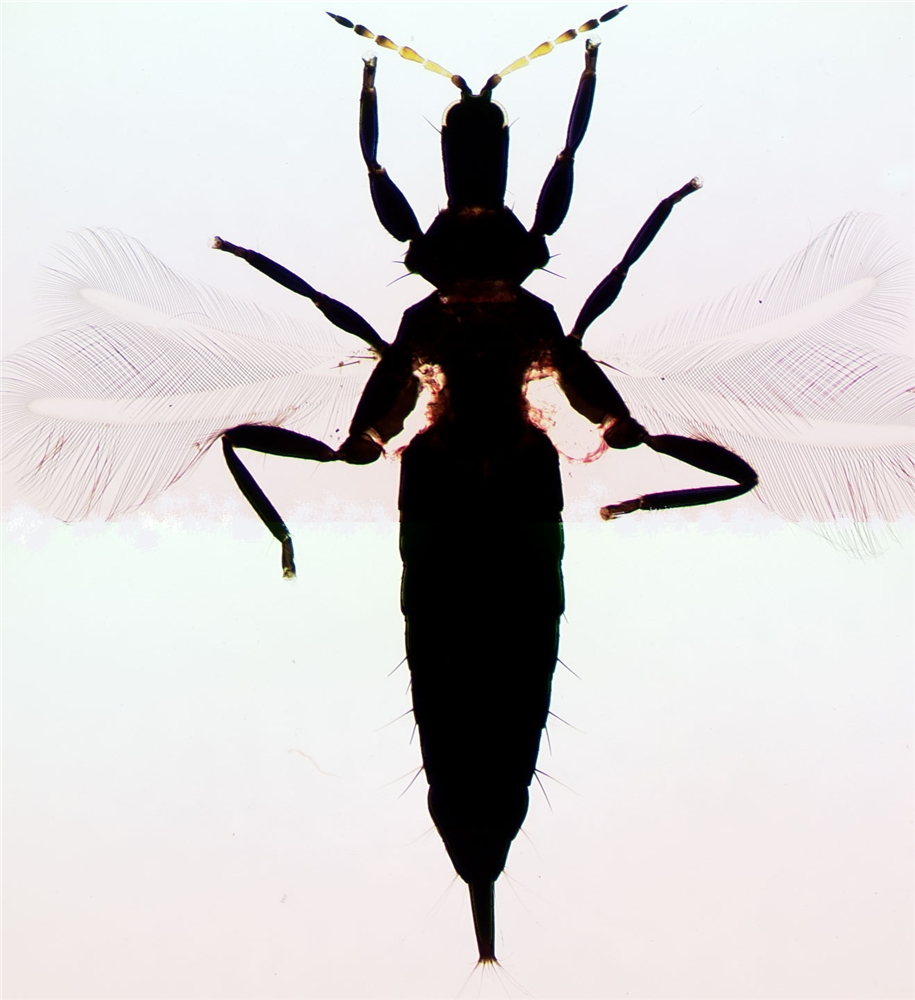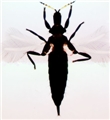Liothrips perseae
Recognition data
Distinguishing features
Both sexes fully winged. Body and legs blackish brown, antennal segment III yellow, IV dark yellow, V - VI variably yellow in basal 0.25 to 0.6; major setae black, setae on tergites VIII - IX pale; forewing pale with weak shading along margins. Head distinctly longer than wide; post ocular setae longer than dorsal length of eyes with apices softly pointed. Antennae 8-segmented; segment III with one sensorium, IV with three sensoria; VIII slender and slightly constricted at base. Pronotum with five pairs of long major setae with blunt apices, posteroangular setae almost as long as median length of pronotum; epimeral sutures complete; prosternal basantra not developed, ferna present, mesopraesternum divided into paired lateral triangles. Fore tarsus without a tooth. Metanotum with narrow elongate reticulation. Forewing parallel sided, with about 25 duplicated cilia; three sub-basal setae sub-equal in length. Tergite IX setae S1 finely acute, about as long as tube. Male with antennal segment VI brown, V yellow at base; tergite IX setae S2 as long and fine as S1; sternite VIII without a glandular area.
Related and similar species
L. perseae is not known from California, but is included here because it is a potential invader given the expanding avocado cultivation in the State. Related to L. avocadis in having tergite IX setae S2 of males as long and fine as setae S1, not short and stout as in the males of most Liothrips species, this species has the antennae more extensively yellow, particularly in females, with shorter sensoria on segments III and IV. The genus Liothrips, with more than 290 described species, is one of the three largest genera of Thysanoptera. However, in comparison to both Thrips and Haplothrips it involves far greater problems for species recognition and systematics. A particularly high proportion of the described species are known from single samples, or even single individuals, resulting in little knowledge of host relationships or of structural variation within and between species. The general assumption that most members of the genus are host-specific requires validation. Stannard (1957) listed 32 species of Liothrips from North America, and subsequently (Stannard, 1968) included 14 of these in his keys to the Illinois fauna. Cott (1957) treated 11 species from California, including two that he placed in Rhynchothrips, but currently from this State there are 13 Liothrips species listed (Hoddle et al., 2004).
Distribution data
Area of origin
Central America
Distribution
Honduras, Guatemala
Biological data
Life history
Breeding on leaves and feeding on young fruit
Host plants
Persea americana (Lauraceae).
Tospoviruses vectored
None
Crop damage
Causing severe damage to leaves and fruit of avocado in Guatemala
Taxonomic data
Current valid name
Liothrips perseae Watson
Original name and synonyms
Liothrips perseae Watson, 1923: 80
Family placement
Phlaeothripidae, Phlaeothripinae







